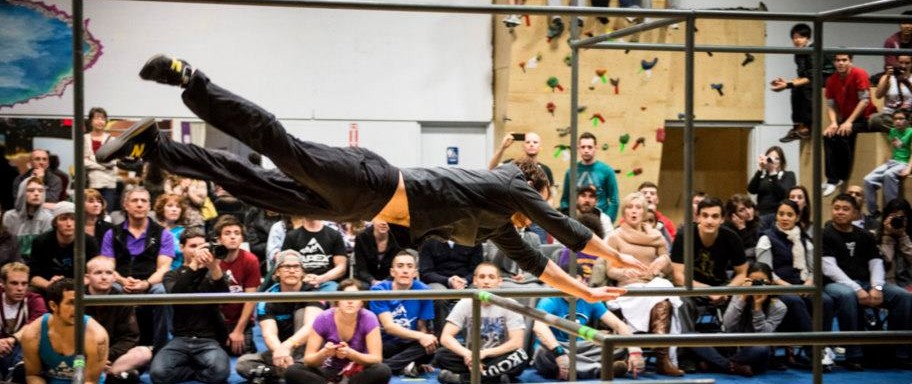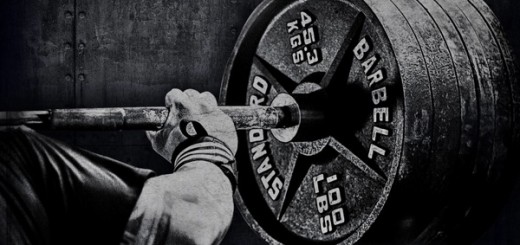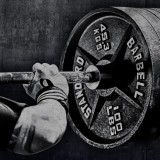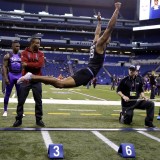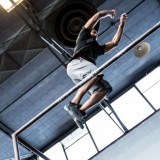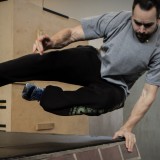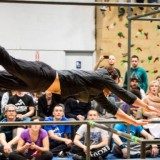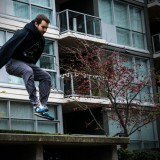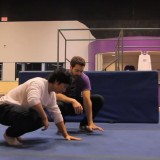Pro Parkour, Pro Competition
Parkour was introduced to me, like most people, through the internet. A friend introduced me to a few parkour videos in 2007. My first training session, a 1:00am blitz through a nearly abandoned college campus, was the catalyst for what would become an obsession with movement and challenge. I received my first shin decoration on a botched vault, but bloodied jeans and throbbing pain were not going to stop me from exploring new possibilities. I was in love with feeling alive so I continued training through the night.
The next day I was unimaginably sore. I was utterly destroyed and a simple staircase looked like Everest. This is when I began researching parkour. I came across forums, articles, and videos from well-respected individuals and read everything I could find. I was caught up in every internet argument concerning parkour and despite being relatively new to the sport, I was pretty militant about my position. Parkour vs freerunning, bodyweight vs weight training, pro vs anti-competition. I would vehemently argue that flips are not parkour, bodyweight training is superior to weight training, and, of course, competition is bad for the discipline.
Why was I so against competition in parkour? To be honest, it was because pretty much everyone else was against it at the time. I remember the forums teeming with “pro parkour, against competition” banners. Quotes from the founders discussing parkour’s non-competitive nature were frequently cited and extensive anti-competition articles were written. The seminal text of the anti-competition front was an authoritative doctrine entitled “Why there are no Parkour competitions,” which was written to outline the disparity between parkour values and those that are promoted through competition. The article cites elitism and injury (both of which were already common to parkour practice) as well as commercialization and prize money. The authors suggested that corporate sponsors and allowing athletes to earn a living through the practice of parkour are fundamentally opposed to the philosophical practice of the discipline (this is despite the founders of parkour appearing in major films). To strengthen my bias, the pro-competition arguments that I heard were often weak and revolved around the single premise that competition in parkour is inevitable, so we may as well accept it. I simply didn’t buy it. Thus, it was difficult for me to understand the potential benefits of parkour competition because the culture of parkour was primarily opposed to the idea.
 Fast forward to 2010, my position on competition shifted away from unwavering opposition. It wasn’t because I heard or read a compelling argument or even because I thought through my own biases. My position shifted because of direct personal experience. This experience came when I moved to Vancouver, BC from Florida to pursue postgraduate education. I was invited to participate in my first grassroots competition that year at Parkour Visions in Seattle where they were experimenting with hosting Ninja Warrior style competitions in their gym. Given my previous interest in Ninja Warrior, I traveled down for the weekend to compete despite my cultural opposition to ‘parkour competition’. While the courses contained a few atypical features (a rope swing and a sled pull) and the event was advertised as a ninja warrior style obstacle course challenge, I realized that the spirit and nature of parkour was still ever present. Each competitor was cheered on and the atmosphere was friendly and supportive. In fact, there was open discussion among the athletes about course strategy. I left the event feeling a buzz of excitement and a renewed conception of competition.
Fast forward to 2010, my position on competition shifted away from unwavering opposition. It wasn’t because I heard or read a compelling argument or even because I thought through my own biases. My position shifted because of direct personal experience. This experience came when I moved to Vancouver, BC from Florida to pursue postgraduate education. I was invited to participate in my first grassroots competition that year at Parkour Visions in Seattle where they were experimenting with hosting Ninja Warrior style competitions in their gym. Given my previous interest in Ninja Warrior, I traveled down for the weekend to compete despite my cultural opposition to ‘parkour competition’. While the courses contained a few atypical features (a rope swing and a sled pull) and the event was advertised as a ninja warrior style obstacle course challenge, I realized that the spirit and nature of parkour was still ever present. Each competitor was cheered on and the atmosphere was friendly and supportive. In fact, there was open discussion among the athletes about course strategy. I left the event feeling a buzz of excitement and a renewed conception of competition.
Up to this point, my only understanding of formalized parkour competition was the big corporate events with poor formatting and reality TV spinning. I realized that if competition was to be enjoyable for athletes and interesting to watch for spectators, it needed to grow out of the grassroots community to reflect the actual practice of the sport. The athletes themselves needed to take matters into their own hands to experiment with what works.
Since then, grassroots parkour competitions have become more frequent, although still too sparse, as more people are beginning to recognize the benefits of competition. The purpose of this article is to discuss competition in parkour as a means to elicit challenge and encourage athlete engagement. I will discuss the role competition plays in modulating challenge, the original intent of parkour practice, the value of competition in measurement and goal setting, and competition in parkour as it is currently practiced. Finally, I will touch on my view of parkour’s future.
Competition and challenge.
The term competition is shrouded with negative connotations particularly amongst the traditional parkour community. Competition is often believed to be the antonym to cooperation. However, the term ‘compete’ comes from the Latin ‘competere’, which means “to strive together” (com– “together” + petere “to strive”). Most people wish to reach their fullest potential. This quest is facilitated when the performance of others encourages you to perform at your best. Competition is a means to not only increase an individual’s ability, but is also a means to increase the standard of ability in a given discipline. When people push their own limits, they inspire the people around them and ultimately, they end up pushing the limits of the sport as a whole. This is not only true for sport, but also for intellectual and artistic domains such as chess, academics, business, dance, music, and the list goes on.
Participants in competitive endeavors experience challenge in a way that can enhance enjoyment and quality of life. However, this is only true if the standard of ability in the given competition is within an individual’s own range of ability. If the challenge is too great, individuals may experience anxiety and become discouraged. No one enjoys watching or participating in a game where the opponents are mismatched. Alternately, if the challenge is not great enough, individuals may become bored and unenthusiastic about their experience. Both scenarios are clearly undesirable.
According to the figure below, the optimal amount of challenge is a range of difficulty that spans from slightly below to slightly above an individual’s level of skill. Mihaly Csikzentmihalyi defines this experience as flow. An individual who maintains a state of flow tends to report greater happiness and well being than those who are overwhelmed or insufficiently challenged. While different levels of challenge have been shown to play a role in motivation and emotional regulation as demonstrated by Csikszentmihalyi, from an information processing perspective the amount of challenge also plays a key role in moderating learning. Skill acquisition research suggests that insufficient challenge results in suboptimal learning, while excessive challenge results in an information overload. In other words, challenge is stress. There is no growth without stress. However, too much stress can be a hindrance to learning and motivation.
Figure adapted from Csikzentmihalyi (1991).
For some people in parkour, practicing the sport as it is currently practiced is sufficient to remain within the ‘flow channel’ or range of optimal challenge. Exploring new spots or revisiting existing training grounds can typically yield more challenge, particularly if the practitioners are creative enough and/or if they have training partners that can inspire new challenge. However, in my experience with parkour there are two groups of athletes that are prone to cessation of practice or ‘dropout’. The first type of athlete is a recreational athlete. These participants can become overwhelmed by difficulty due to a lack of quality instruction and guidance, which may cause them to lose interest and quit. These practitioners can suffer from early plateaus as a result of incomplete understanding of how to progressively increase challenge and measure their current ability. They also may lose sight of their overall purpose for training and, without a purpose, it becomes difficult to maintain motivation. Not to mention, they likely have a job or career outside of the parkour world which demands much of their time and attention.
The second type of athlete at risk of dropout are the elite level athletes. Often relying on parkour skills to make a living through stunt or performance work, these athletes have reached such a high level of performance that they begin to lose interest in the sport. For these individuals parkour practice has lost much of the novelty that initially drew them into the practice and they report a general feeling of boredom. In fact, their focus may shift toward other hobbies or disciplines because, without the excitement of uncertainty and without the challenge of the unknown, enjoyment begins to fade.
Escape or Reach?
“At the physical end, Parkour is getting over all the obstacles in your path as you would in an emergency situation. You want to move in such a way, with any movement, that will help you gain the most ground on someone/something as if escaping from someone/something or chasing toward someone/something.”
-David Belle, Founder of Parkour
According to David Belle, parkour is a utilitarian discipline. One which  teaches the individual practitioner how to move in dire circumstances. Common examples include: rushing into a burning building to save a life or escaping from a persistent attacker. While these examples are extreme and unlikely to occur in one’s lifetime, they remain the traditional examples of how parkour training could be applied in real world, dire circumstances. For those parkour athletes whose stated goal is to be capable of responding to such scenarios, it would be useful to measure their speed in various environmental problems. Timed runs are a useful means of documenting improvements in acceleration and preservation of speed, establishing effective movements in various scenarios with different environmental constraints, and training with the added pressure of performing under time constraints.
teaches the individual practitioner how to move in dire circumstances. Common examples include: rushing into a burning building to save a life or escaping from a persistent attacker. While these examples are extreme and unlikely to occur in one’s lifetime, they remain the traditional examples of how parkour training could be applied in real world, dire circumstances. For those parkour athletes whose stated goal is to be capable of responding to such scenarios, it would be useful to measure their speed in various environmental problems. Timed runs are a useful means of documenting improvements in acceleration and preservation of speed, establishing effective movements in various scenarios with different environmental constraints, and training with the added pressure of performing under time constraints.
Measurement is an important factor in setting and achieving goals. Without measurement, it is difficult to identify whether or not progress has been made. When the overarching goal of the sport is to move quickly through a given environment, an objective measure of speed is essential for determining improvement. Thus, timed navigation can help to document progress. It provides useful feedback about performance that extends beyond the subjective assessment of how fast it feels and objectively assesses how fast it actually was. Considering the recreational athletes in parkour prone to early plateaus (and quitting) mentioned in the previous section, the opportunity to participate in an event intended to measure their progress and identify weaknesses in their ‘game’ may be the key to keeping them engaged in the sport. “Open” competitions exist in other sports such as running and bouldering, but parkour’s lack of open entry competitions is hindering the retention of participation in recreational parkour practice.
Not all movements are created equal. Depending on the environmental constraints, the morphological structure, and the motor repertoire of the athlete, some movements are going to consistently yield faster times than others. Thus, an athlete should experiment with his own movement to identify what works best given the current environmental problem. Additionally, it would be in the athlete’s best interest to train among others of a similar level of skill and ability. Analysis of the friend’s performance and strategy on the course might help identify holes in one’s own execution of particular movements or reveal movement decisions that result in faster navigation of the course. This knowledge can then be used to improve the practitioner’s ability to respond to future environmental problems in training, competition, or real world circumstances.
Again, if the stated goal is to be capable of performing under emergency circumstances, then one must be able to cope with external psychological stress. The vast majority of parkour training occurs under relatively stable and controlled conditions. There is a significant degree of psychological stress inherent to many parkour specific movements and this stress is particularly present in complex environments. However, parkour athletes rarely present themselves with secondary psychological stress in training. Secondary psychological stressors are stressors that are external to those inherent to the initial task conditions such as a timer, an audience, or a pursuant. If an athlete has never experienced this type of stress when executing a run through obstacles, then we can expect that they will not be fully prepared for circumstances in which secondary psychological stressors are present as in emergency situations…or competition.
Embracing the solution
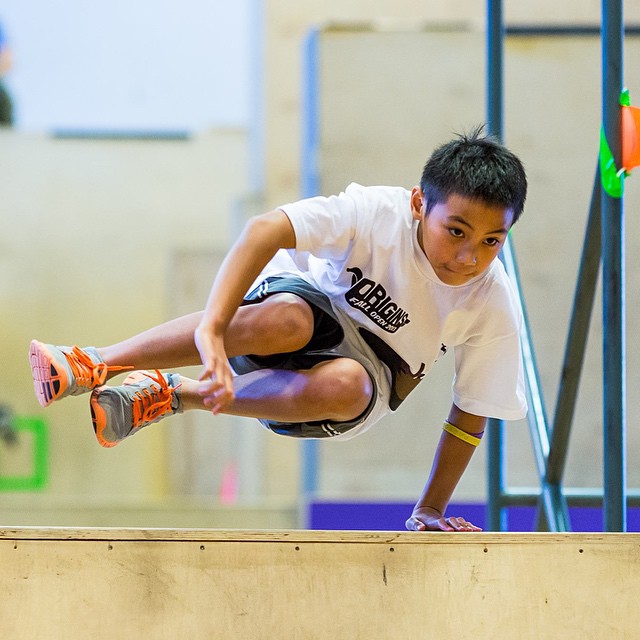 A standardized format for a parkour-themed competition can help offer athletes an outlet for increasing challenge in order to progress themselves, stay engaged, and continue pushing the sport forward. However, competition already exists in parkour and has existed since its creation. This statement may be surprising for those who argue against competition. However, ‘competition’ is a broad term that encompasses the full gamut of social contexts for which people train. Outside of formalized competition, in which an explicit determination of hierarchy of athletic performance is measured via qualitative or quantitative means, there are a number of other forms of competition that are widely accepted and encouraged in the parkour community.
A standardized format for a parkour-themed competition can help offer athletes an outlet for increasing challenge in order to progress themselves, stay engaged, and continue pushing the sport forward. However, competition already exists in parkour and has existed since its creation. This statement may be surprising for those who argue against competition. However, ‘competition’ is a broad term that encompasses the full gamut of social contexts for which people train. Outside of formalized competition, in which an explicit determination of hierarchy of athletic performance is measured via qualitative or quantitative means, there are a number of other forms of competition that are widely accepted and encouraged in the parkour community.
Group training & jams
The large gatherings of practitioners called ‘jams’, for instance, involve an implicit determination of hierarchy for performance. Athletes at jams will often explore the movement possibilities of a given environment and will increase the difficulty of particular challenges until the physical or mental limits of the athletes are reached. Often times participants will organically separate into subgroups of comparable skill level to attempt challenges that are generally within or near each member’s range of optimal challenge. If you can recall the last time you were out training with a friend or group of friends of comparable skill level, it is likely that you were engaging in cooperative competition. While the primary goal is to improve your own ability, you were probably excited if you achieved a particular challenge first or frustrated if you were unable to successfully complete the challenge when others were successful. Additionally, you may have been inspired to try something new or fully commit to a jump that you otherwise would not have tried if you were with a different group of athletes or training alone. Moreover, this form of competition need not involve direct rivalry among participants because the sport of parkour is not analogous to warfare the way team sports are. In parkour, there is no direct human opposition. Thus, it is acceptable to cheer for another athlete when they successfully complete a challenge, even if you are still struggling to perform it. The opposite is also true.
Video competition
Competition in parkour also comes in the form of youtube videos. Video athletes find ways to increase the difficulty of existing challenges or find new ones in their home environment or travel to other environments for the same ends. The athletes in parkour are encouraged to uniquely apply skills and abilities to the environment. With a good parkour video comes increased viewership and notoriety in the international parkour community, which may result in sponsorships, performance work, or other career opportunities at the highest levels of ability. People who regularly upload videos aim to gain subscribers and views. Once again, direct rivalry is not commonplace because a successful video does not necessarily depend on the failure of another video.
First ascents
The term “first ascent” comes from the sport of rock climbing. It refers to the first time someone completes a route that has never been ascended previously. Whoever completes a first ascent is granted the opportunity to name and rate the route. Within climbing culture, this is one of the most sought after achievements. To find what no one else has done and carve a new path for others to follow. While this concept does not exist as firmly in parkour, there does exist a form of first ascent in parkour. One variation of a first ascent in parkour is when an athlete seeks out a brand new spot and discovers a challenge for the first time. The completion of this challenge would mark a “first ascent” and if the challenge is difficult enough the community would recognize this as a great achievement. The challenge may even take years of mental or physical preparation to complete, for example Dylan Baker’s recent parkade climb in the final episode of his Baker Blog series.
Another variation of a first ascent in parkour is when a new skill is applied to a well known parkour spot. For example, the first time someone successfully achieves a kong to precision between two walls when the best anyone previously has accomplished was a kong to cat. The specific example that comes to mind is when Pip front flipped the IMAX gap in London. In less than ten years, the standard of ability in parkour progressed so much that a front flip over that gap seemed impossible when the spot was first discovered. Since Pip’s first ascent at IMAX others have been inspired to attempt flipping the gap because the standard had been raised and the impossible no longer seems so.
Childhood games
It is often repeated that the founders of parkour developed the sport out of childhood games. They played with their imagination with ground is lava, follow the leader, and role playing-type games. Then they carried the spirit and the movements into their adulthood. One of the most repeated quotes I’ve heard in parkour is from George Bernard Shaw who said “we don’t stop playing because we grow old; we grow old because we stop playing.” As a parkour coach who regularly works with kids, I see competition among kids of all ages. A game of tag is perhaps one of the most clearly competitive childhood games and also one of the most rudimentary. One person is ‘it’ and the others must get away using their skills and ability to avoid being ‘it’. It is a gamified version of David Belle’s quote referenced in the previous section of this article. Children also spontaneously organize foot races to see who is the fastest or jumping games to see who can jump the farthest. There are countless examples of kids being competitive because competition is in our nature. So to add to Shaw’s quote, “we don’t stop competing because we grow old…”
Obstacle courses
Before I was introduced to parkour, I had come across a Japanese TV show called “Sasuke”, or Ninja Warrior to the English speaking audience. I was enthralled by the athleticism and humility displayed by the competitors on the show. They did not compete against one another, rather, they were competing against four seemingly unconquerable obstacle courses. In 2008, Levi Meeuwenberg and Brian Orosco became the first parkour athletes to compete in Sasuke. This launched the TV show, American Ninja Warrior (ANW), which now holds tryouts for the competition every year. These tryouts are widely attended by parkour athletes in the US.
The fact that Ninja Warrior has received the support of many parkour athletes tells us two things:
First, parkour athletes are interested in competition. They seek out opportunities for challenge and enjoy finding situations that enable them to use their unique abilities. Particularly if they think they can excel. Since Ninja Warrior involves many physical challenges that suit the abilities afforded by parkour, it is only fitting for parkour athletes to pursue this competition format.
Second, if parkour athletes are training for Ninja Warrior, they are not training for parkour. Remember, Ninja Warrior is a standardized obstacle course competition. It includes many abnormal obstacles that are specific to Ninja Warrior. For better or worse, time, energy, and recovery spent training the elements required to navigate Ninja Warrior courses is time away from training to increase performance in parkour. This becomes a problem when an athlete’s primary goal is to improve at parkour, yet also wishes to engage in competition.
Since the increased popularity of ANW, parkour gyms around the world have catered to budding Ninja Warrior market by building replicas of existing ANW obstacles and hosting an ever increasing number of obstacle course competitions. But dammit, we are parkour athletes and our community needs more formalized, parkour-specific competitions to promote the development of the sport. Otherwise, competitive parkour athletes will settle for non-specific competition, a digression away from the overarching goal of parkour.
Conclusion
In 2012, I became head coach working alongside Rene Scavington at Origins Parkour and Athletic Facility with the goal of developing the most effective methods of improving parkour skill and ability. A crucial step towards this goal is the development of measurement methods as a way of tracking progress. Standardized tests of skill, ability, and preparedness are required to accurately assess improvement and competition is one such measurement tool.
In February of 2013, Rene and I, having organized several successful open competitions, designed and organized the first ever North American Parkour Championships (NAPC). The second NAPC was hosted in May of 2014 and the next main event is scheduled for August 2015.
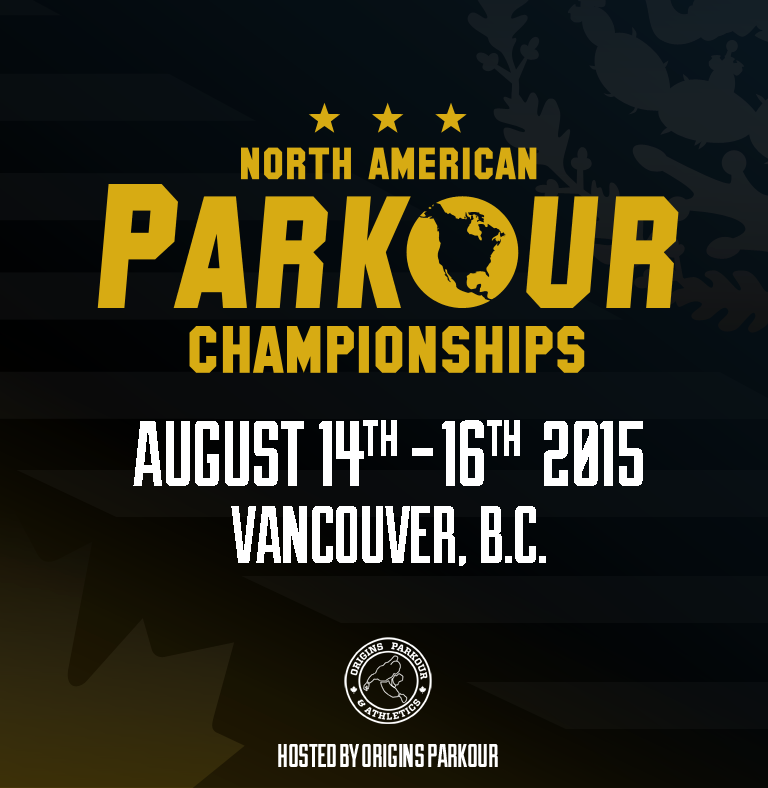 This competition consists of 3 events representing 3 styles of parkour practice: Skill, Speed, and Style. The Skills portion is intended to measure an athlete’s ability to perform a particular category of skill in a complex environment. It is completion-based rather than time-oriented, meaning that the highest difficulty movement chosen with the best execution determines the winner. The Speed event, the most objective of the 3 events, is intended to measure how fast the athletes can complete a designated course. Courses are carefully designed so that they do not dictate the movements the athletes choose, but rather the direction of movement. This ensures that the speed courses measure not only an individual’s athletic ability, but also the effectiveness of their movement strategy and mental fortitude. Finally, we included a freestyle event. The Style portion was intended to include the athletes that practice the more acrobatic elements of parkour. It is a judged event that is intended to measure the difficulty and execution of runs that the athletes put together.
This competition consists of 3 events representing 3 styles of parkour practice: Skill, Speed, and Style. The Skills portion is intended to measure an athlete’s ability to perform a particular category of skill in a complex environment. It is completion-based rather than time-oriented, meaning that the highest difficulty movement chosen with the best execution determines the winner. The Speed event, the most objective of the 3 events, is intended to measure how fast the athletes can complete a designated course. Courses are carefully designed so that they do not dictate the movements the athletes choose, but rather the direction of movement. This ensures that the speed courses measure not only an individual’s athletic ability, but also the effectiveness of their movement strategy and mental fortitude. Finally, we included a freestyle event. The Style portion was intended to include the athletes that practice the more acrobatic elements of parkour. It is a judged event that is intended to measure the difficulty and execution of runs that the athletes put together.
Because of major competitions such as Red Bull Art of Motion and other high profile media emerging from the parkour world, the freestyle element of parkour has become the most popular and fastest growing of the various styles. While I believe this is positive and healthy for the sport, the foundation of parkour is being neglected. Fewer people are getting into the speed and efficiency element of the sport in favor of learning acrobatic skills of higher complexity. This only increases the need for speed and skill oriented competitions for parkour. As these types of competitions become more frequent and prominent in the parkour world, the value of cultivating speed and efficiency in obstacle courses and developing the fundamental parkour skills like kongs, jumps, and laches will be greatly increased.
Competition serves as a way to stay engaged with the sport. Whether it is used in an effort to push yourself, inspire others, or increase the standard of ability in parkour. It offers a method of measuring and testing progress and it has existed in some form since parkour’s inception. Parkour competitions in the future will yield more access to parkour for recreation and create more opportunities to turn parkour into a career. Whether the individual aspires to be a high level athlete competing for prize money or a parkour coach introducing parkour to future generations and developing the skills of top athletes, parkour competition will enable more people to follow their passion and encourage a lasting engagement with the sport.
References
(1) Hebertiste & TK 17, (2007). Why there are no parkour competitions. Retrieved from http://parkourpedia.com/other/why-there-are-no-parkour-competitions
(2) Compete. (n.d.). In Online Etymology Dictionary. Retrieved from http://www.etymonline.com/index.php?term=compete
(3) Csikzentmihalyi, M. (1991). Flow: The Psychology of Optimal Experience. New York: Harper & Row.
(4) Guadagnoli, M. A., & Lee, T. D. (2004). Challenge point: a framework for conceptualizing the effects of various practice conditions. Journal of Motor Behaviour, 36, 212-224.
(5) Cak010. (2006, December 19). Cali meets David Belle [Msg 1]. Message posted to http://www.pkcali.com/parkour_plugins/content/content.php?content.8
(6) Baker, D. (2014, November 3). Overcome fear and accomplish bigger goals in parkour. Retrieved from http://dylanbakerparkour.com/accomplishing-big-goals-in-parkour/
(7) INSANE FRONTFLIP! ft. Pip ‘Piptrix’ Andersen – Parkour/FreeRunning OFFICIAL [Video File]. Retrieved from https://www.youtube.com/watch?v=83YaUZAJYxA

